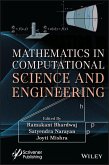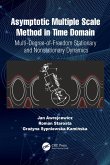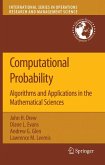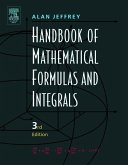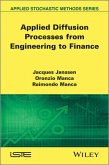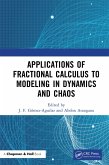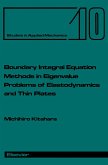Mathematics in Computational Science and Engineering (eBook, PDF)
Redaktion: Bhardwaj, Ramakant; Suseendran, Gopalakrishnan; Narayan, Satyendra; Mishra, Jyoti


Alle Infos zum eBook verschenken

Mathematics in Computational Science and Engineering (eBook, PDF)
Redaktion: Bhardwaj, Ramakant; Suseendran, Gopalakrishnan; Narayan, Satyendra; Mishra, Jyoti
- Format: PDF
- Merkliste
- Auf die Merkliste
- Bewerten Bewerten
- Teilen
- Produkt teilen
- Produkterinnerung
- Produkterinnerung

Hier können Sie sich einloggen

Bitte loggen Sie sich zunächst in Ihr Kundenkonto ein oder registrieren Sie sich bei bücher.de, um das eBook-Abo tolino select nutzen zu können.
MATHEMATICS IN COMPUTATIONAL SCIENCE AND ENGINEERING This groundbreaking new volume, written by industry experts, is a must-have for engineers, scientists, and students across all engineering disciplines working in mathematics and computational science who want to stay abreast with the most current and provocative new trends in the industry. Applied science and engineering is the application of fundamental concepts and knowledge to design, build and maintain a product or a process, which provides a solution to a problem and fulfills a need. This book contains advanced topics in computational…mehr
- Geräte: PC
- mit Kopierschutz
- eBook Hilfe
- Größe: 13.87MB
![Mathematics in Computational Science and Engineering (eBook, ePUB) Mathematics in Computational Science and Engineering (eBook, ePUB)]() Mathematics in Computational Science and Engineering (eBook, ePUB)173,99 €
Mathematics in Computational Science and Engineering (eBook, ePUB)173,99 €![Asymptotic Multiple Scale Method in Time Domain (eBook, PDF) Asymptotic Multiple Scale Method in Time Domain (eBook, PDF)]() Jan AwrejcewiczAsymptotic Multiple Scale Method in Time Domain (eBook, PDF)47,95 €
Jan AwrejcewiczAsymptotic Multiple Scale Method in Time Domain (eBook, PDF)47,95 €![Computational Probability (eBook, PDF) Computational Probability (eBook, PDF)]() John H. DrewComputational Probability (eBook, PDF)81,95 €
John H. DrewComputational Probability (eBook, PDF)81,95 €![Handbook of Mathematical Formulas and Integrals (eBook, PDF) Handbook of Mathematical Formulas and Integrals (eBook, PDF)]() Alan JeffreyHandbook of Mathematical Formulas and Integrals (eBook, PDF)27,95 €
Alan JeffreyHandbook of Mathematical Formulas and Integrals (eBook, PDF)27,95 €![Applied Diffusion Processes from Engineering to Finance (eBook, PDF) Applied Diffusion Processes from Engineering to Finance (eBook, PDF)]() Jacques JanssenApplied Diffusion Processes from Engineering to Finance (eBook, PDF)169,99 €
Jacques JanssenApplied Diffusion Processes from Engineering to Finance (eBook, PDF)169,99 €![Applications of Fractional Calculus to Modeling in Dynamics and Chaos (eBook, PDF) Applications of Fractional Calculus to Modeling in Dynamics and Chaos (eBook, PDF)]() Applications of Fractional Calculus to Modeling in Dynamics and Chaos (eBook, PDF)192,95 €
Applications of Fractional Calculus to Modeling in Dynamics and Chaos (eBook, PDF)192,95 €![Boundary Integral Equation Methods in Eigenvalue Problems of Elastodynamics and Thin Plates (eBook, PDF) Boundary Integral Equation Methods in Eigenvalue Problems of Elastodynamics and Thin Plates (eBook, PDF)]() M. KitaharaBoundary Integral Equation Methods in Eigenvalue Problems of Elastodynamics and Thin Plates (eBook, PDF)40,95 €
M. KitaharaBoundary Integral Equation Methods in Eigenvalue Problems of Elastodynamics and Thin Plates (eBook, PDF)40,95 €-
-
Dieser Download kann aus rechtlichen Gründen nur mit Rechnungsadresse in A, B, BG, CY, CZ, D, DK, EW, E, FIN, F, GR, HR, H, IRL, I, LT, L, LR, M, NL, PL, P, R, S, SLO, SK ausgeliefert werden.
- Produktdetails
- Verlag: Wiley-IEEE Press
- Seitenzahl: 448
- Erscheinungstermin: 27. April 2022
- Englisch
- ISBN-13: 9781119777540
- Artikelnr.: 63927087
- Verlag: Wiley-IEEE Press
- Seitenzahl: 448
- Erscheinungstermin: 27. April 2022
- Englisch
- ISBN-13: 9781119777540
- Artikelnr.: 63927087
- Herstellerkennzeichnung Die Herstellerinformationen sind derzeit nicht verfügbar.
1 Brownian Motion in EOQ 1
K. Suganthi and G. Jayalalitha
1.1 Introduction 2
1.2 Assumptions in EOQ 4
1.2.1 Model Formulation 4
1.2.1.1 Assumptions 4
1.2.1.2 Notations 4
1.2.1.3 Inventory Ordering Cost 4
1.2.1.4 Inventory Holding Cost 5
1.2.1.5 Inventory Total Cost in EOQ 5
1.2.2 Example 5
1.2.3 Inventory Control Commodities in Instantaneous Demand Method Under
Development of the tock 7
1.2.3.1 Assumptions 8
1.2.3.2 Notations 8
1.2.3.3 Model Formulation 9
1.2.3.4 Numerical Examples 10
1.2.3.5 Sensitivity Analysis 11
1.2.4 Classic EOQ Method in Inventory 12
1.2.4.1 Assumptions 12
1.2.4.2 Notations 13
1.2.4.3 Mathematical Model 13
1.3 Methodology 15
1.3.1 Brownian Motion 16
1.4 Results 17
1.4.1 Numerical Examples 20
1.4.2 Sensitivity Analysis 20
1.4.3 Brownian Path in Hausdorff Dimension 21
1.4.4 The Hausdorff Measure 22
1.4.5 Levy Processes 22
1.5 Discussion 23
1.5.1 Future Research 23
1.6 Conclusions 24
References 24
2 Ill-Posed Resistivity Inverse Problems and its Application to
Geoengineering Solutions 27
Satyendra Narayan
2.1 Introduction 28
2.2 Fundamentals of Ill-Posed Inverse Problems 29
2.3 Brief Historical Development of Resistivity Inversion 30
2.4 Overview of Inversion Schemes 31
2.5 Theoretical Basis for Multi-Dimensional Resistivity Inversion
Technqiues 32
2.6 Mathematical Concept for Application to Geoengineering Problems 40
2.7 Mathematical Quantification of Resistivity Resolution and Detection 43
2.8 Scheme of Resistivity Data Presentation 45
2.9 Design Strategy for Monitoring Processes of IOR Projects,
Geo-Engineering, and Geo-Environmental Problems 47
2.10 Final Remarks and Conclusions 49
References 51
3 Shadowed Set and Decision-Theoretic Three-Way Approximation of Fuzzy Sets
55
M. A. Ibrahim, T. O. William-West and D. Singh
3.1 Introduction 55
3.2 Preliminaries on Three-Way Approximation of Fuzzy Sets 57
3.2.1 Shadowed Set Approximation 57
3.2.2 Decision-Theoretic Three-Way Approximation 58
3.3 Theoretical Foundations of Shadowed Sets 60
3.3.1 Uncertainty Balance Models 61
3.3.1.1 Pedrycz's (Pd) Model 61
3.3.1.2 Tahayori-Sadeghian-Pedrycz (TSP) Model 61
3.3.1.3 Ibrahim-William-West-Kana-Singh (IWKS) Model 62
3.3.2 Minimum Error or Deng-Yao (DY) Model 63
3.3.3 Average Uncertainty or Ibrahim-West (IW) Model 64
3.3.4 Nearest Quota of Uncertainty (WIK) Model 65
3.3.5 Algorithm for Constructing Shadowed Sets 65
3.3.6 Examples on Shadowed Set Approximation 66
3.4 Principles for Constructing Decision-Theoretic Approximation 73
3.4.1 Deng and Yao Special Decision-Theoretic (DYSD) Model 74
3.4.2 Zhang, Xia, Liu and Wang (ZXLW) Generalized Decision-Theoretic Model
77
3.4.3 A General Perspective to Decision-Theoretic Three-Way Approximation
78
3.4.3.1 Determination of n, m and p for Decision- Theoretic Three-Way
Approximation 79
3.4.3.2 A General Decision-Theoretic Three-Way Approximation Partition
Thresholds 81
3.4.4 Example on Decision-Theoretic Three-Way Approximation 83
3.5 Concluding Remarks and Future Directions 87
References 88
4 Intuitionistic Fuzzy Rough Sets: Theory to Practice 91
Shivani Singh and Tanmoy Som
4.1 Introduction 92
4.2 Preliminaries 93
4.2.1 Rough Set Theory 94
4.2.2 Intuitionistic Fuzzy Set Theory 95
4.2.3 Intuitionistic Fuzzy-Rough Set Theory 96
4.3 Intuitionistic Fuzzy Rough Sets 97
4.4 Extension and Hybridization of Intuitionistic Fuzzy Rough Sets 110
4.4.1 Extension 110
4.4.1.1 Dominance-Based Intuitionistic Fuzzy Rough Sets 111
4.4.1.2 Covering-Based Intuitionistic Fuzzy Rough Sets 111
4.4.1.3 Kernel Intuitionistic Fuzzy Rough Sets 112
4.4.1.4 Tolerance-Based Intuitionistic Fuzzy Rough Sets 112
4.4.1.5 Interval-Valued Intuitionistic Fuzzy Rough Sets 112
4.4.2 Hybridization 113
4.4.2.1 Variable Precision Intuitionistic Fuzzy Rough Sets 113
4.4.2.2 Intuitionistic Fuzzy Neighbourhood Rough Sets 114
4.4.2.3 Intuitionistic Fuzzy Multigranulation Rough Sets 114
4.4.2.4 Intuitionistic Fuzzy Decision-Theoretic Rough Sets 114
4.4.2.5 Intuitionistic Fuzzy Rough Sets and Soft Intuitionistic Fuzzy Rough
Sets 115
4.4.2.6 Multi-Adjoint Intuitionistic Fuzzy Rough Sets 115
4.4.2.7 Intuitionistic Fuzzy Quantified Rough Sets 116
4.4.2.8 Genetic Algorithm and IF Rough Sets 116
4.5 Applications of Intuitionistic Fuzzy Rough Sets 116
4.5.1 Attribute Reduction 116
4.5.2 Decision Making 118
4.5.3 Other Applications 119
4.6 Work Distribution of IFRS Country-Wise and Year-Wise 123
4.6.1 Country-Wise Work Distribution 123
4.6.2 Year-Wise Work Distribution 124
4.6.3 Limitations of Intuitionistic Fuzzy Rough Set Theory 124
4.7 Conclusion 125
Acknowledgement 125
References 125
5 Satellite-Based Estimation of Ambient Particulate Matters (pm 2.5) Over a
Metropolitan City in Eastern India 135
Tamanna Nasrin, Sharadia Dey and Sabyasachi Mondal
5.1 Introduction 136
5.2 Methodology 137
5.3 Result and Discussions 138
5.4 Conclusion 143
References 144
6 Computational Simulation Techniques in Inventory Management 147
Dr. Abhijit Pandit and Dr. Pulak Konar
6.1 Introduction 147
6.1.1 Inventory Management 147
6.1.2 Simulation 148
6.2 Conclusion 164
References 165
7 Workability of Cement Mortar Using Nano Materials and PVA 167
Dr. Mohan Kantharia and Dr. Pankaj Mishra
7.1 Introduction 167
7.2 Literature Survey 168
7.3 Materials and Methods 171
7.4 Results and Discussion 171
7.5 Conclusion 177
References 178
8 Distinctive Features of Semiconducting and Brittle Half-Heusler Alloys;
LiXP (X=Zn, Cd) 181
Madhu Sarwan, Abdul Shukoor V. and Sadhna Singh
8.1 Introduction 182
8.2 Computation Method 183
8.3 Result and Discussion 183
8.3.1 Structural Properties 183
8.3.2 Elastic Properties 185
8.3.3 Electronic Properties 187
8.3.4 Thermodynamic Properties 190
8.4 Conclusions 195
Acknowledgement 196
References 196
9 Fixed Point Results with Fuzzy Sets 199
Qazi Aftab Kabir, Sanath Kumar H.G. and Ramakant Bhardwaj
9.1 Introduction 199
9.2 Definitions and Preliminaries 200
9.3 Main Results 201
References 208
10 Role of Mathematics in Novel Artificial Intelligence Realm 211
Kavita Rawat and Manas Kumar Mishra
10.1 Introduction 212
10.2 Mathematical Concepts Applied in Artificial Intelligence 212
10.2.1 Linear Algebra 213
10.2.1.1 Matrix and Vectors 213
10.2.1.2 Eigen Value and Eigen Vector 214
10.2.1.3 Matrix Operations 217
10.2.1.4 Artificial Intelligence Algorithms That Use Linear Algebra 217
10.2.2 Calculus 218
10.2.2.1 Objective Function 219
10.2.2.2 Loss Function & Cost Function 219
10.2.2.3 Artificial Intelligence Algorithms That Use Calculus 222
10.2.3 Probability and Statistics 222
10.2.3.1 Population Versus Sample 224
10.2.3.2 Descriptive Statistics 224
10.2.3.3 Distributions 225
10.2.3.4 Probability 225
10.2.3.5 Correlation 226
10.2.3.6 Data Visualization Using Statistics 226
10.2.3.7 Artificial Intelligence Algorithms That Use Probability and
Statistics 227
10.3 Work Flow of Artificial Intelligence & Application Areas 227
10.3.1 Application Areas 229
10.3.2 Trending Areas 229
10.4 Conclusion 230
References 231
11 Study of Corona Epidemic: Predictive Mathematical Model 233
K. Sruthila Gopala Krishnan, Ramakant Bhardwaj, Amit Kumar Mishra and
Rakesh Mohan Shrraf
11.1 Mathematical Modelling 234
11.2 Need of Mathematical Modelling 235
11.3 Methods of Construction of Mathematical Models 236
11.3.1 Mathematical Modelling with the Help of Geometry 236
11.3.2 Mathematical Modelling with the Help of Algebra 237
11.3.3 Mathematical Modelling Using Trigonometry 239
11.3.4 Mathematical Modelling with the Help of Ordinary Differential
Equation (ODE) 239
11.3.5 Mathematical Modelling Using Partial Differential Equation (PDE) 240
11.3.6 Mathematical Modelling Using Difference Equation 240
11.4 Comparative Study of Mathematical Model in the Time of Covid-19 - A
Review 241
11.4.1 Review 241
11.4.2 Case Study 246
11.5 Corona Epidemic in the Context of West Bengal: Predictive Mathematical
Model 247
11.5.1 Overview 247
11.5.2 Case Study 248
11.5.3 Methodology 250
11.5.3.1 Exponential Model 250
11.5.3.2 Model Based on Geometric Progression (g.p.) 252
11.5.3.3 Model for Stay At Home 253
11.5.4 Discussion 255
References 255
12 Application of Mathematical Modeling in Various Fields in Light of Fuzzy
Logic 257
Dr. Dhirendra Kumar Shukla
12.1 Introduction 257
12.1.1 Mathematical Modeling 257
12.1.2 Principles of Mathematical Models 259
12.2 Fuzzy Logic 261
12.2.1 Fuzzy Cognitive Maps & Induced Fuzzy Cognitive Maps 262
12.2.2 Fuzzy Cluster Means 263
12.3 Literature Review 264
12.4 Applications of Fuzzy Logic 268
12.4.1 Controller of Temperature 269
12.4.2 Usage of Fuzzy Logic in a Washing Machine 270
12.4.3 Air Conditioner 271
12.4.4 Aeronautics 272
12.4.5 Automotive Field 272
12.4.6 Business 274
12.4.7 Finance 275
12.4.8 Chemical Engineering 276
12.4.9 Defence 278
12.4.10 Electronics 279
12.4.11 Medical Science and Bioinformatics 280
12.4.12 Robotics 282
12.4.13 Signal Processing and Wireless Communication 283
12.4.14 Transportation Problems 283
12.5 Conclusion 285
References 285
13 A Mathematical Approach Using Set & Sequence Similarity Measure for Item
Recommendation Using Sequential Web Data 287
Vishal Paranjape, Dr. Neelu Nihalani, Dr. Nishchol Mishra and Dr. Jyoti
Mishra
13.1 Introduction 288
13.2 Measures of Assessment for Recommendation Engines 294
13.3 Related Work 295
13.4 Methodology/Research Design 296
13.4.1 Web Data Collection Through Web Logs 296
13.4.2 Web User Sessions Classification 300
13.5 Finding or Result 305
13.6 Conclusion and Future Work 306
References 307
14 Neural Network and Genetic Programming Based Explicit Formulations for
Shear Capacity Estimation of Adhesive Anchors 311
Tawfik Kettanah and Satyendra Narayan
14.1 General Introduction 312
14.2 Research Significance 313
14.3 Biological Nervous System 314
14.4 Constructing Artificial Neural Network Model 317
14.5 Genetic Programming (GP) 320
14.6 Administering Genetic Programming Scheme 320
14.7 Genetic Programming In Details 320
14.8 Genetic Expression Programming 322
14.9 Developing Model With Genexpo Software 322
14.10 Comparing NN and GEP Results 325
14.11 Conclusions 326
References 327
15 Adaptive Heuristic - Genetic Algorithms 329
R. Anandan
15.1 Introduction 329
15.2 Genetic Algorithm 330
15.3 The Genetic Algorithm 331
15.4 Evaluation Module 331
15.5 Populace Module 331
15.5.1 Introduction 331
15.5.2 Initialisation Technique 331
15.5.3 Deletion Technique 332
15.5.4 Parent Selection Procedure 332
15.5.5 Fitness Technique 333
15.5.6 Populace Size 333
15.5.7 Elitism 334
15.6 Reproduction Module 334
15.6.1 Introduction 334
15.6.2 Operators 334
15.6.3 Mutation 338
15.6.4 Mutation Rate 338
15.6.5 Crossover Rate 338
15.6.6 Dynamic Mutation and Crossover Rates 338
15.7 Example 339
15.8 Schema Theorem 341
15.8.1 Introduction 341
15.9 Conclusion 342
15.10 Future Scope 342
References 342
16 Mathematically Enhanced Corrosion Detection 343
SeyedBijan Mahbaz, Giovanni Cascante, Satyendra Narayan, Maurice B.
Dusseault and Philippe Vanheeghe
16.1 Introduction 344
16.1.1 Mathematics in NDT 346
16.1.2 Principal Component Analysis (PCA) 347
16.2 Case Study: PCA Applied to PMI Data for Defect Detection 347
16.3 PCA Feature Extraction for PMI Method 349
16.4 Experimental Setup and Test 351
16.5 Results 352
16.6 Conclusions 355
References 355
17 Dynamics of Malaria Parasite with Effective Control Analysis 359
Nagadevi Bala Nagaram and Suresh Rasappan
17.1 Introduction 359
17.2 The Mathematical Structure of EGPLC 361
17.3 The Modified EGPLC Model 363
17.4 Equilibria and Local Stability Analysis 364
17.5 Analysis of Global Stability 365
17.6 Global Stability Analysis with Back Propagation 367
17.7 Stability Analysis of Non-Deterministic EGPLC Model 373
17.8 Discussion on Numerical Simulation 378
17.9 Conclusion 381
17.10 Future Scope of the Work 381
References 381
18 Dynamics, Control, Stability, Diffusion and Synchronization of Modified
Chaotic Colpitts Oscillator with Triangular Wave Non-Linearity Depending on
the States 383
Suresh Rasappan and Niranjan Kumar K.A.
18.1 Introduction 384
18.2 The Mathematical Model of Chaotic Colpitts Oscillator 385
18.3 Adaptive Backstepping Control of the Modified Colpitts Oscillator with
Unknown Parameters 395
18.3.1 Proposed System 395
18.3.2 Numerical Simulation 400
18.4 Synchronization of Modified Chaotic Colpitts Oscillator 400
18.4.1 Synchronization of Modified Chaotic Colpitts Oscillator using
Non-Linear Feedback Method 402
18.4.2 Numerical Simulation 404
18.5 The Synchronization of Colpitts Oscillator via Backstepping Control
405
18.5.1 Analysis of the Error Dynamics 405
18.5.2 Numerical Simulation 408
18.6 Circuit Implementation 409
18.7 Conclusion 412
References 412
Index 415
1 Brownian Motion in EOQ 1
K. Suganthi and G. Jayalalitha
1.1 Introduction 2
1.2 Assumptions in EOQ 4
1.2.1 Model Formulation 4
1.2.1.1 Assumptions 4
1.2.1.2 Notations 4
1.2.1.3 Inventory Ordering Cost 4
1.2.1.4 Inventory Holding Cost 5
1.2.1.5 Inventory Total Cost in EOQ 5
1.2.2 Example 5
1.2.3 Inventory Control Commodities in Instantaneous Demand Method Under
Development of the tock 7
1.2.3.1 Assumptions 8
1.2.3.2 Notations 8
1.2.3.3 Model Formulation 9
1.2.3.4 Numerical Examples 10
1.2.3.5 Sensitivity Analysis 11
1.2.4 Classic EOQ Method in Inventory 12
1.2.4.1 Assumptions 12
1.2.4.2 Notations 13
1.2.4.3 Mathematical Model 13
1.3 Methodology 15
1.3.1 Brownian Motion 16
1.4 Results 17
1.4.1 Numerical Examples 20
1.4.2 Sensitivity Analysis 20
1.4.3 Brownian Path in Hausdorff Dimension 21
1.4.4 The Hausdorff Measure 22
1.4.5 Levy Processes 22
1.5 Discussion 23
1.5.1 Future Research 23
1.6 Conclusions 24
References 24
2 Ill-Posed Resistivity Inverse Problems and its Application to
Geoengineering Solutions 27
Satyendra Narayan
2.1 Introduction 28
2.2 Fundamentals of Ill-Posed Inverse Problems 29
2.3 Brief Historical Development of Resistivity Inversion 30
2.4 Overview of Inversion Schemes 31
2.5 Theoretical Basis for Multi-Dimensional Resistivity Inversion
Technqiues 32
2.6 Mathematical Concept for Application to Geoengineering Problems 40
2.7 Mathematical Quantification of Resistivity Resolution and Detection 43
2.8 Scheme of Resistivity Data Presentation 45
2.9 Design Strategy for Monitoring Processes of IOR Projects,
Geo-Engineering, and Geo-Environmental Problems 47
2.10 Final Remarks and Conclusions 49
References 51
3 Shadowed Set and Decision-Theoretic Three-Way Approximation of Fuzzy Sets
55
M. A. Ibrahim, T. O. William-West and D. Singh
3.1 Introduction 55
3.2 Preliminaries on Three-Way Approximation of Fuzzy Sets 57
3.2.1 Shadowed Set Approximation 57
3.2.2 Decision-Theoretic Three-Way Approximation 58
3.3 Theoretical Foundations of Shadowed Sets 60
3.3.1 Uncertainty Balance Models 61
3.3.1.1 Pedrycz's (Pd) Model 61
3.3.1.2 Tahayori-Sadeghian-Pedrycz (TSP) Model 61
3.3.1.3 Ibrahim-William-West-Kana-Singh (IWKS) Model 62
3.3.2 Minimum Error or Deng-Yao (DY) Model 63
3.3.3 Average Uncertainty or Ibrahim-West (IW) Model 64
3.3.4 Nearest Quota of Uncertainty (WIK) Model 65
3.3.5 Algorithm for Constructing Shadowed Sets 65
3.3.6 Examples on Shadowed Set Approximation 66
3.4 Principles for Constructing Decision-Theoretic Approximation 73
3.4.1 Deng and Yao Special Decision-Theoretic (DYSD) Model 74
3.4.2 Zhang, Xia, Liu and Wang (ZXLW) Generalized Decision-Theoretic Model
77
3.4.3 A General Perspective to Decision-Theoretic Three-Way Approximation
78
3.4.3.1 Determination of n, m and p for Decision- Theoretic Three-Way
Approximation 79
3.4.3.2 A General Decision-Theoretic Three-Way Approximation Partition
Thresholds 81
3.4.4 Example on Decision-Theoretic Three-Way Approximation 83
3.5 Concluding Remarks and Future Directions 87
References 88
4 Intuitionistic Fuzzy Rough Sets: Theory to Practice 91
Shivani Singh and Tanmoy Som
4.1 Introduction 92
4.2 Preliminaries 93
4.2.1 Rough Set Theory 94
4.2.2 Intuitionistic Fuzzy Set Theory 95
4.2.3 Intuitionistic Fuzzy-Rough Set Theory 96
4.3 Intuitionistic Fuzzy Rough Sets 97
4.4 Extension and Hybridization of Intuitionistic Fuzzy Rough Sets 110
4.4.1 Extension 110
4.4.1.1 Dominance-Based Intuitionistic Fuzzy Rough Sets 111
4.4.1.2 Covering-Based Intuitionistic Fuzzy Rough Sets 111
4.4.1.3 Kernel Intuitionistic Fuzzy Rough Sets 112
4.4.1.4 Tolerance-Based Intuitionistic Fuzzy Rough Sets 112
4.4.1.5 Interval-Valued Intuitionistic Fuzzy Rough Sets 112
4.4.2 Hybridization 113
4.4.2.1 Variable Precision Intuitionistic Fuzzy Rough Sets 113
4.4.2.2 Intuitionistic Fuzzy Neighbourhood Rough Sets 114
4.4.2.3 Intuitionistic Fuzzy Multigranulation Rough Sets 114
4.4.2.4 Intuitionistic Fuzzy Decision-Theoretic Rough Sets 114
4.4.2.5 Intuitionistic Fuzzy Rough Sets and Soft Intuitionistic Fuzzy Rough
Sets 115
4.4.2.6 Multi-Adjoint Intuitionistic Fuzzy Rough Sets 115
4.4.2.7 Intuitionistic Fuzzy Quantified Rough Sets 116
4.4.2.8 Genetic Algorithm and IF Rough Sets 116
4.5 Applications of Intuitionistic Fuzzy Rough Sets 116
4.5.1 Attribute Reduction 116
4.5.2 Decision Making 118
4.5.3 Other Applications 119
4.6 Work Distribution of IFRS Country-Wise and Year-Wise 123
4.6.1 Country-Wise Work Distribution 123
4.6.2 Year-Wise Work Distribution 124
4.6.3 Limitations of Intuitionistic Fuzzy Rough Set Theory 124
4.7 Conclusion 125
Acknowledgement 125
References 125
5 Satellite-Based Estimation of Ambient Particulate Matters (pm 2.5) Over a
Metropolitan City in Eastern India 135
Tamanna Nasrin, Sharadia Dey and Sabyasachi Mondal
5.1 Introduction 136
5.2 Methodology 137
5.3 Result and Discussions 138
5.4 Conclusion 143
References 144
6 Computational Simulation Techniques in Inventory Management 147
Dr. Abhijit Pandit and Dr. Pulak Konar
6.1 Introduction 147
6.1.1 Inventory Management 147
6.1.2 Simulation 148
6.2 Conclusion 164
References 165
7 Workability of Cement Mortar Using Nano Materials and PVA 167
Dr. Mohan Kantharia and Dr. Pankaj Mishra
7.1 Introduction 167
7.2 Literature Survey 168
7.3 Materials and Methods 171
7.4 Results and Discussion 171
7.5 Conclusion 177
References 178
8 Distinctive Features of Semiconducting and Brittle Half-Heusler Alloys;
LiXP (X=Zn, Cd) 181
Madhu Sarwan, Abdul Shukoor V. and Sadhna Singh
8.1 Introduction 182
8.2 Computation Method 183
8.3 Result and Discussion 183
8.3.1 Structural Properties 183
8.3.2 Elastic Properties 185
8.3.3 Electronic Properties 187
8.3.4 Thermodynamic Properties 190
8.4 Conclusions 195
Acknowledgement 196
References 196
9 Fixed Point Results with Fuzzy Sets 199
Qazi Aftab Kabir, Sanath Kumar H.G. and Ramakant Bhardwaj
9.1 Introduction 199
9.2 Definitions and Preliminaries 200
9.3 Main Results 201
References 208
10 Role of Mathematics in Novel Artificial Intelligence Realm 211
Kavita Rawat and Manas Kumar Mishra
10.1 Introduction 212
10.2 Mathematical Concepts Applied in Artificial Intelligence 212
10.2.1 Linear Algebra 213
10.2.1.1 Matrix and Vectors 213
10.2.1.2 Eigen Value and Eigen Vector 214
10.2.1.3 Matrix Operations 217
10.2.1.4 Artificial Intelligence Algorithms That Use Linear Algebra 217
10.2.2 Calculus 218
10.2.2.1 Objective Function 219
10.2.2.2 Loss Function & Cost Function 219
10.2.2.3 Artificial Intelligence Algorithms That Use Calculus 222
10.2.3 Probability and Statistics 222
10.2.3.1 Population Versus Sample 224
10.2.3.2 Descriptive Statistics 224
10.2.3.3 Distributions 225
10.2.3.4 Probability 225
10.2.3.5 Correlation 226
10.2.3.6 Data Visualization Using Statistics 226
10.2.3.7 Artificial Intelligence Algorithms That Use Probability and
Statistics 227
10.3 Work Flow of Artificial Intelligence & Application Areas 227
10.3.1 Application Areas 229
10.3.2 Trending Areas 229
10.4 Conclusion 230
References 231
11 Study of Corona Epidemic: Predictive Mathematical Model 233
K. Sruthila Gopala Krishnan, Ramakant Bhardwaj, Amit Kumar Mishra and
Rakesh Mohan Shrraf
11.1 Mathematical Modelling 234
11.2 Need of Mathematical Modelling 235
11.3 Methods of Construction of Mathematical Models 236
11.3.1 Mathematical Modelling with the Help of Geometry 236
11.3.2 Mathematical Modelling with the Help of Algebra 237
11.3.3 Mathematical Modelling Using Trigonometry 239
11.3.4 Mathematical Modelling with the Help of Ordinary Differential
Equation (ODE) 239
11.3.5 Mathematical Modelling Using Partial Differential Equation (PDE) 240
11.3.6 Mathematical Modelling Using Difference Equation 240
11.4 Comparative Study of Mathematical Model in the Time of Covid-19 - A
Review 241
11.4.1 Review 241
11.4.2 Case Study 246
11.5 Corona Epidemic in the Context of West Bengal: Predictive Mathematical
Model 247
11.5.1 Overview 247
11.5.2 Case Study 248
11.5.3 Methodology 250
11.5.3.1 Exponential Model 250
11.5.3.2 Model Based on Geometric Progression (g.p.) 252
11.5.3.3 Model for Stay At Home 253
11.5.4 Discussion 255
References 255
12 Application of Mathematical Modeling in Various Fields in Light of Fuzzy
Logic 257
Dr. Dhirendra Kumar Shukla
12.1 Introduction 257
12.1.1 Mathematical Modeling 257
12.1.2 Principles of Mathematical Models 259
12.2 Fuzzy Logic 261
12.2.1 Fuzzy Cognitive Maps & Induced Fuzzy Cognitive Maps 262
12.2.2 Fuzzy Cluster Means 263
12.3 Literature Review 264
12.4 Applications of Fuzzy Logic 268
12.4.1 Controller of Temperature 269
12.4.2 Usage of Fuzzy Logic in a Washing Machine 270
12.4.3 Air Conditioner 271
12.4.4 Aeronautics 272
12.4.5 Automotive Field 272
12.4.6 Business 274
12.4.7 Finance 275
12.4.8 Chemical Engineering 276
12.4.9 Defence 278
12.4.10 Electronics 279
12.4.11 Medical Science and Bioinformatics 280
12.4.12 Robotics 282
12.4.13 Signal Processing and Wireless Communication 283
12.4.14 Transportation Problems 283
12.5 Conclusion 285
References 285
13 A Mathematical Approach Using Set & Sequence Similarity Measure for Item
Recommendation Using Sequential Web Data 287
Vishal Paranjape, Dr. Neelu Nihalani, Dr. Nishchol Mishra and Dr. Jyoti
Mishra
13.1 Introduction 288
13.2 Measures of Assessment for Recommendation Engines 294
13.3 Related Work 295
13.4 Methodology/Research Design 296
13.4.1 Web Data Collection Through Web Logs 296
13.4.2 Web User Sessions Classification 300
13.5 Finding or Result 305
13.6 Conclusion and Future Work 306
References 307
14 Neural Network and Genetic Programming Based Explicit Formulations for
Shear Capacity Estimation of Adhesive Anchors 311
Tawfik Kettanah and Satyendra Narayan
14.1 General Introduction 312
14.2 Research Significance 313
14.3 Biological Nervous System 314
14.4 Constructing Artificial Neural Network Model 317
14.5 Genetic Programming (GP) 320
14.6 Administering Genetic Programming Scheme 320
14.7 Genetic Programming In Details 320
14.8 Genetic Expression Programming 322
14.9 Developing Model With Genexpo Software 322
14.10 Comparing NN and GEP Results 325
14.11 Conclusions 326
References 327
15 Adaptive Heuristic - Genetic Algorithms 329
R. Anandan
15.1 Introduction 329
15.2 Genetic Algorithm 330
15.3 The Genetic Algorithm 331
15.4 Evaluation Module 331
15.5 Populace Module 331
15.5.1 Introduction 331
15.5.2 Initialisation Technique 331
15.5.3 Deletion Technique 332
15.5.4 Parent Selection Procedure 332
15.5.5 Fitness Technique 333
15.5.6 Populace Size 333
15.5.7 Elitism 334
15.6 Reproduction Module 334
15.6.1 Introduction 334
15.6.2 Operators 334
15.6.3 Mutation 338
15.6.4 Mutation Rate 338
15.6.5 Crossover Rate 338
15.6.6 Dynamic Mutation and Crossover Rates 338
15.7 Example 339
15.8 Schema Theorem 341
15.8.1 Introduction 341
15.9 Conclusion 342
15.10 Future Scope 342
References 342
16 Mathematically Enhanced Corrosion Detection 343
SeyedBijan Mahbaz, Giovanni Cascante, Satyendra Narayan, Maurice B.
Dusseault and Philippe Vanheeghe
16.1 Introduction 344
16.1.1 Mathematics in NDT 346
16.1.2 Principal Component Analysis (PCA) 347
16.2 Case Study: PCA Applied to PMI Data for Defect Detection 347
16.3 PCA Feature Extraction for PMI Method 349
16.4 Experimental Setup and Test 351
16.5 Results 352
16.6 Conclusions 355
References 355
17 Dynamics of Malaria Parasite with Effective Control Analysis 359
Nagadevi Bala Nagaram and Suresh Rasappan
17.1 Introduction 359
17.2 The Mathematical Structure of EGPLC 361
17.3 The Modified EGPLC Model 363
17.4 Equilibria and Local Stability Analysis 364
17.5 Analysis of Global Stability 365
17.6 Global Stability Analysis with Back Propagation 367
17.7 Stability Analysis of Non-Deterministic EGPLC Model 373
17.8 Discussion on Numerical Simulation 378
17.9 Conclusion 381
17.10 Future Scope of the Work 381
References 381
18 Dynamics, Control, Stability, Diffusion and Synchronization of Modified
Chaotic Colpitts Oscillator with Triangular Wave Non-Linearity Depending on
the States 383
Suresh Rasappan and Niranjan Kumar K.A.
18.1 Introduction 384
18.2 The Mathematical Model of Chaotic Colpitts Oscillator 385
18.3 Adaptive Backstepping Control of the Modified Colpitts Oscillator with
Unknown Parameters 395
18.3.1 Proposed System 395
18.3.2 Numerical Simulation 400
18.4 Synchronization of Modified Chaotic Colpitts Oscillator 400
18.4.1 Synchronization of Modified Chaotic Colpitts Oscillator using
Non-Linear Feedback Method 402
18.4.2 Numerical Simulation 404
18.5 The Synchronization of Colpitts Oscillator via Backstepping Control
405
18.5.1 Analysis of the Error Dynamics 405
18.5.2 Numerical Simulation 408
18.6 Circuit Implementation 409
18.7 Conclusion 412
References 412
Index 415

